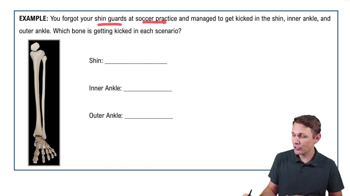Ms. Cho presents with muscle pain in the area around her anterior neck and superior chest. She explains that she has had a respiratory infection over the past 2 weeks that made it hard for her to breathe. What is likely causing her muscle soreness? (Hint: Remember that the origin and insertion of some muscles can switch and that one likely has to breathe more deeply with a respiratory infection.)
Elise is a competitive gymnast who strained muscles in her left lower limb doing a tumbling pass. She has pain with extension of her leg and inversion of her foot. Which muscles did she potentially strain?
 Verified step by step guidance
Verified step by step guidance
Verified video answer for a similar problem:
Key Concepts
Muscle Anatomy of the Lower Limb

Mechanics of Gymnastics Movements

Common Sports Injuries

Match the term with its description:
_____Brevis
_____Digitorum
_____Hallucis
_____Rectus
_____Flexor
_____Pronatora.
a. Related to the fingers/toes
b. Straightc.
c. Short
d.Decreases the angle between bones
e. Turns palm down
f. Related to the hallux (great toe)
Why do you think that the muscles of the erector spinae and transversospinal muscle groups remain in a state of continual contraction when we are upright?
The action of the biceps brachii muscle on the hinge joint of the elbow is an example of which kind of lever system?
a. First class
b. Second class
c. Third class
d. Fourth class
Why do the three parts of the trapezius muscle have three different actions?
Chris is training for his black belt in karate and is working on developing a stronger punch. Which muscles do you recommend that he strengthen to improve his punch? Explain.
